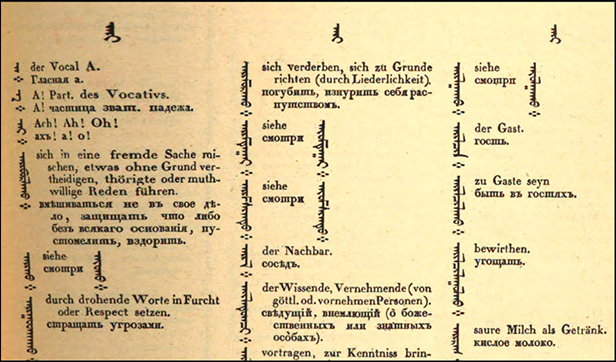20 Mongolian Cyrillic (Khalkha)

The expansion of the Russian Empire’s frontiers toward Manchu China meant interactions with several different Mongolic language groups that inhabit Siberia and the Far East, including Buryat and Oirat variants. The official Khalka dialect is prominent in the Republic of Mongolia. The 19th-century digitized book presented here is one of the earliest dictionaries of Mongolian language that was published by the Imperial Academy of Sciences in Saint Petersburg. We are highlighting this specific dictionary in consultation with the faculty members that teach and conduct their research in Mongolian. The scripts of the Mongolian language have evolved over the long history of the Mongols. Due to the Sovietization of Outer Mongolia, the alphabet was changed to Cyrillic characters (Khalkha) while the Inner Mongolia of the People’s Republic of China continued to use a variant of the traditional script which is called Uyghur-Mongolian.
Several UCB faculty members focus their research on Mongolia. Among them is Professor Emerita Patricia Berger, an art historian, and Professor Jacob Dalton, who is a world known specialist on Tibetan Buddhism. Tibetan Buddhism’s history and practice are syncretic to both past and present practice to the Buddhism of Mongolia. Brian Baumann is a lecturer of Mongolian language in East Asian Languages and Cultures and is instrumental in teaching language courses. Professor Sanjyot Mehendale, who teaches courses on Central Asia and the Silk Roads in the Department of Near Eastern Studies, is an archaeologist specializing in Eurasian trade and cultural exchange of the early Common Era. She has worked on several archaeology sites and projects in Central Asia, including Samarkand and Afghanistan.
The Mongolia collection has been developed to reconnect students with the history of Mongolia and the surrounding region. Besides students, the collection development revolves around the needs of faculty members and other scholars at UC Berkeley. Mongolia’s ethnic composition represents a unique tapestry of the Central Asian nationalities living within the geographic boundaries of the region along with the Mongols. The Department of East Asian Languages and Cultures offers courses related to Mongolia which vary from elementary Mongolian to Mongolian Buddhist Ritual (Buddhist Studies 190).1 While the collection of Mongolian language books from the Republic of Mongolia printed in Cyrillic is approximately 1800 titles, Doe Library acquired nearly 800 new titles from 2009 through 2019. Besides, Mongolian language materials, we also have an extensive collection of books in Kazakh, Kyrgyz, Tajik, Turkmen and Uzbek languages.
As a librarian for East European and Central Asian Studies, I focused initially on collecting materials related to Buryat Mongols of Siberia. With a generous gift from the government of Mongolia, UC Berkeley and the Institute of East Asian Studies were delighted to announce the establishment of the Mongolia Initiative. This initiative led to the beginning of the teaching of Mongolian on campus for the first time in many years. Thus, the need for the collections of materials in Mongolian from the Republic of Mongolia became an ever-pressing reality. Since 2015, UC Berkeley has also received funding from the U.S. Department of Education to begin teaching elementary Mongolian. This National Resource Center grant recognizes UC Berkeley as a national leader for teaching and research on East Asia, including Mongolia.2 It funds the education of lesser-taught world languages, in particular Mongolian, which is one of the critical languages for the national security of the United States government.3
Contribution by Liladhar Pendse
Librarian for the Mongolian Collections, Doe Library
Sources consulted:
- Mongolian (MONGLN) Berkeley Academic Guide – UCB (accessed 6/24/19)
- About the Mongolia Initiative, UC Berkeley (accessed 6/24/19)
- “Mongolia,” The World Factbook (accessed 5/11/21)
Title in English: Mongolian-German-Russian Dictionary: In addition to a German and a Russian word index.
Author: Schmidt, Isaak Jakob, 1779-1847.
Imprint: Sanktpeterburg: Kaiserliche Akademie der Wissenschaften, 1835.
Edition: 1st.
Language: Mongolian Cyrillic (Khalkha)
Language Family: Mongolic
Source: HathiTrust Digital Library (UCLA)
URL: https://hdl.handle.net/2027/uc1.d0006851489
Other online editions:
- Bayerische Staatsbibliothek (BSB)
http://mdz-nbn-resolving.de/urn:nbn:de:bvb:12-bsb10691089-1
Select Print editions at Berkeley:
- Schmidt, Isaak J. Mongolisch-deutsch-russisches Wörterbuch: Nebst Einem Deutschen Und Einem Rusischen Wortregister. St. Petersburg: Bei den commissionairen der Kaiserlichen akademie der wissenschaften, W. Graeff und Glasunow, 1835.

